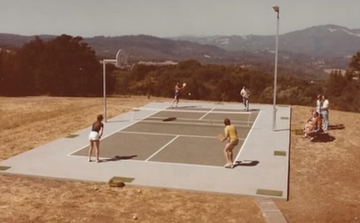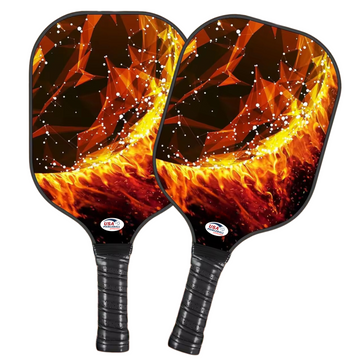Pickleball began as a simple backyard game. It was founded in the mid-1960s to entertain a family on Bainbridge Island, Washington. It combined elements of tennis, badminton, and ping-pong. Making it accessible and fun for players of all ages and skill levels.
Its straightforward rules turned pickleball from a family pastime into an organized sport. Known in the United States and beyond with its growing community. Today, it attracts a diverse community of players and is acknowledged worldwide. Equipped with specialized courts and organized tournaments.
Origins of Pickleball
Better grip, lighter weight, more power — today’s paddles are game changers
Pickleball began as a fun game played in someone’s backyard. It didn’t take long for it to grow into an organized sport. The game was started by a few people in a specific place, and over time, they made changes to the rules and equipment. These changes helped shape the game into what it is today.
Creation on Bainbridge Island
Pickleball began in 1965 on Bainbridge Island, Washington. The game began when three families wanted a fun activity to play together during the summer.
They improvised by combining elements from badminton, tennis, and table tennis. A lowered net, wooden paddles and a perforated plastic ball was first used.
The location was important because the island atmosphere encouraged outdoor play. The openness to trying new things. Paved the way to establish itself in the community before gaining popularity.
The Inventors: Joel Pritchard, Bill Bell, and Barney McCallum
Three friends, one idea, and a backyard legacy that changed the world of sports
Joel Pritchard, Bill Bell, and Barney McCallum are recognized as the inventors of pickleball. Pritchard and Bell were businessmen and politicians who wanted a family oriented game.
They invited McCallum, an experienced athlete, to help refine the rules and equipment. Together, the trio adapted their ideas to make the game accessible to all ages and skill levels.
Their joint effort led to pickleball. Ensuring it was easy to play and competitive, which laid the foundation for its future growth.
Early Rules and Equipment
The first rules of pickleball were a simplified mix from other racket sports. The net was set at 36 inches at the sidelines and 34 inches in the middle.
Players used homemade wooden paddles and a Wiffle ball. Chosen for its lightweight and slow flight. The court was about 20 feet by 44 feet, smaller than a tennis court, making it easier to manage.
Early rules emphasized serving underhand and double bounces before volleys. A limited area called a "kitchen" where volleys are not allowed to reduce fast moving play close to the net.
Pickleball's Growth in the United States
Early rules focused on keeping the game controlled and fair —
-
Players had to serve underhand,
-
Let the ball bounce once on each side before hitting it in the air
-
Avoid volleying in a small area near the net called the "kitchen" to prevent fast, aggressive play
Formation of Organized Play and First Tournaments
The first formal pickleball tournaments appeared in the mid-1970s. These events helped turn a backyard pastime into a competitive sport. Small communities, particularly in Washington state and California, hosted early competitions.
When the tournament play began, the rules established and attracted more players. These rules were for all skill levels. During the 1980s, more regional and national tournaments emerged, forming a competitive circuit
Its openness helped the sport grow past its roots in retiree and family communities
Establishment of Governing Bodies
In 1984, with the aim of standardizing the game and encouraging its national growth. It paved the way in establishing USAPA. It focused on creating a consistent rulebook for players and referees.
USAPA helped certify officials and organized annual championships. Which became a cornerstone for competitive pickleball. Its efforts supported growth in membership and club formations.
The organization extended its reach to community programs, schools, and senior centers. Later renamed USA Pickleball, . It serves as the primary authority for the sport’s development in the US.
Media Coverage and Public Awareness
In the 2000s, Pickleball media exposure increased. Coverage highlighted the sport’s accessibility and growing player base.
Broadcasts of major tournaments on platforms like ESPN expanded public knowledge. Social media further accelerated awareness by sharing instructional videos and player stories.
Local news outlets showcased pickleball as a recreational option. Especially in parks and community centers. This helped convert casual interest into more regular participation nationwide.
Global Expansion and Modern Development
Pickleball’s popularity has grown alongside rapid international adoption. Integration into educational and community programs, and the rise of formal competitive leagues. These changes have evolved pickleball into a sport that is open to everyone. Backed by the well-established professional foundation.
International Spread and Popularity
Pickleball began expanding beyond the United States in the early 2010s. Countries like Canada, Spain, and India saw early adoption. Fueled by increasing media exposure and social media trends. Today, over 80 countries have active pickleball communities.
Many international pickleball organizations have formed. That includes the International Federation of Pickleball (IFP). Which promotes standardized rules and global competition. Tournaments worldwide attract diverse age groups, helping grow the sport’s popularity further.
The game’s appeal lies in its low equipment cost and easy learning curve. Adapting well to countries with limited sports infrastructure.
Inclusion in Schools and Community Programs
Schools and community centers have incorporated pickleball as an inclusive physical activity. Many school districts in the U.S. and Canada have added pickleball in physical education.
Community programs use pickleball to connect older adults with active lifestyles. It also engages youth unfamiliar with traditional racket sports. The USA Pickleball Youth Committee supports development through clinics or events targeting youth.
The game's adaptability to small courts makes it suitable for urban environments. Increasing its adoption in diverse educational settings.
Professionalization and Competitive Leagues
The establishment of professional leagues has been critical in showcasing pickleball's competitive side. The Professional Pickleball Association (PPA) and Major League Pickleball (MLP) organized tournaments. Additionally, with prize money and media coverage.
Top players now have sponsorships and global followings. In effect, it raises the sport’s profile. Fans worldwide have gained access because of the televised matches and streaming services.
Rule standardization and advanced training methods have improved the quality of play. Attracting athletes from other racket sports and driving performance standards higher.
Pickleball's Cultural Impact
Pickleball's rise continues to affect entertainment and everyday health habits. It shapes media representation, social connection, and how people engage in physical activity.
Integration into Pop Culture
Pickleball appears in television shows. Even in commercials and podcasts, often highlighting its accessibility and social nature. The sport has gained even more attention. Thanks to public support from celebrities like Bill Gates and George Clooney.
Several companies have taken advantage of this popularity by launching branded gear. Even sponsoring tournaments as it will increase their visibility in the media. Endorsements place pickleball in a growing niche of mainstream leisure activities.
It attracts people of all ages and from all areas. Reflected in its inclusion in community events and schools. The sport has simple rules. Hence, promotes social interaction and a welcoming image that media outlets emphasize.
Influence on Active Lifestyles
Pickleball encourages participation among older adults seeking low-impact exercise. It offers moderate cardio and agility training without intense strain. Making it suitable for wide skill ranges.
Communities often report increased social engagement linked to regular pickleball play. This results in mental health benefits alongside physical activity. Contributing to its appeal as a lifestyle activity.
Fitness professionals recommend pickleball for balance and coordination improvement. Its friendly competition model fosters motivation and consistent exercise habits in diverse populations.


